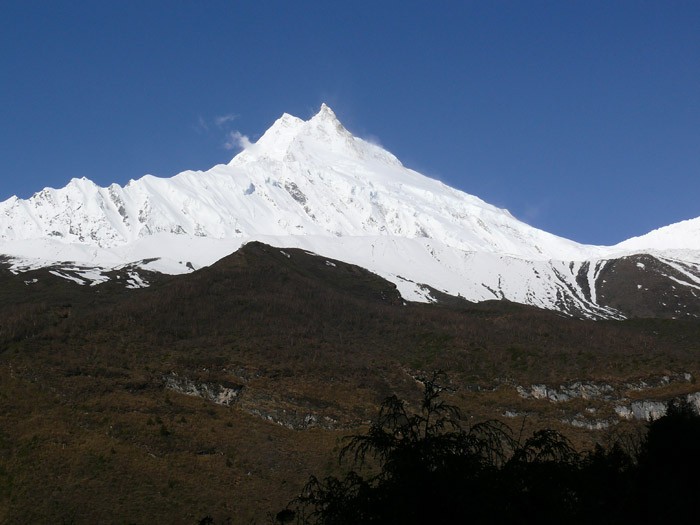The Himalayan chain rose in the last 30 – 40 million years, as the continental plate of India pushed in under Asia. It stretches for 2800km in a west-northwest to east-southeast direction forming a crescent arc from Afghanistan in the west to Burma (Myanmar) in the east. Beginning near Mount Kailash, the Indus River flows west and turns south around Nanga Parbat (8125m) Pakistan. The Yarlung Tsangpo River rises to the east of Mt Kailash and flows eastwards to Namche Barwa before turning south (and becomes the Brahmaputra River). These rivers roughly embrace the Himalayan chain: which contains all 14 of the earth’s 8000m peaks. One third of this range lies along Nepal’s northern border and includes 8 of the giants.
Explorers, trekkers and “borderholics” have long gazed wistfully at the remote mountain valleys that border Tibet. These regions have been “off limits” for many decades as they offer easy access to the high trade passes into the land that wished to remain closed to the countries to the south. Occasional visitors returned with stories of a Shangri La steeped in the unknown Tibetan culture.
The fabulous and varied scenery of high altitude deserts and mysterious hidden valleys in the dry western Upper Dolpo and Upper Mustang regions contrasts to the deep jungle gorges of Manaslu and the forested valleys below Kangchenjunga’s massive bulk.
Altitude and climate has played its part in determining the mix of peoples who inhabit these regions: broadly speaking, Hindus in the lower valleys and Buddhist cultures higher up with overlaps developing with time. Trekking in the wilderness areas is as much a cultural experience as a physical and visual one.
In October 1991 Nepal’s Home Ministry finally announced the opening of the restricted areas. The first to open were Inner Dolpo and Nupri – the region north of Manaslu. In 1993: Upper Mustang and then the western Humla region (allowing cross border treks to Tibet’s Mt. Kailash). The mysterious Nar Phu valley (and a former settlement of Khampa Tibetan armed rebels) was opened in 2002.
Our wilderness treks follow ancient caravan and animal trails, and offer the ultimate opportunity of exploring cultures that have been largely untouched by ‘modern civilization’. The Kangchenjunga, Makalu, Ganesh Himal and Rolwaling Valley trails are particularly stimulating both in their variety of landscape, fauna and flora, as well as the rich local cultural heritage. Consider these treks as special, if rougher, alternatives to the crowded Annapurna, Langtang and parts of the Everest trails.
Main Navigation
- Home
-
- Mardi Himal Trek
- Annapurna Base Camp Trek
- Annapurna Circuit Trek
- Annapurna Panorama Trek
- Poon Hill Sunrise Trek
- Annapurna Sanctuary Trek
- Nar Phu Valley Trek
- Poon Hill Trek
- Annapurna Sunrise Trek
- Ghorepani Poon Hill Trek
- Ghorepani Ghandruk Loop Trek
- 4 Days Poon Hill Trek
- Annapurna Short Trek
- Poon Hill Annapurna Base Camp Trek
- Poon Hill Trekking package
- Short Mardi Himal Trek
- 5 days Annapurna Base Camp Trek
- 6 Days Annapurna Base Camp Trek
- 10 Days Poon Hill Annapurna Base Camp Trek
-
- EBC Helicopter Tour with Landing - 1 Day
- Luxury EBC Trek with Helicopter Return - 5 Days
- EBC Trek with Helicopter Return - 10 Days
- Short Everest Base Camp Trek - 11 Days
- Short Classic Everest Base Camp Trek - 12 Days
- Classic Everest Base Camp Trek - 14 Days
- Everest Base Camp Luxury Trek - 14 Days
- Gokyo Lakes Trek -14 Days
- Short Comfort EBC Trek -13 Days
- Comfort Everest Base Camp Trek - 15 Days
- Gokyo Renjo La Pass Trek - 15 Days
- Gokyo Cho La Pass EBC Trek - 18 Days
- Everest Three High Pass Trek - 19 days
- Blog
- Contact Us
Main Navigation
- Home
-
- Mardi Himal Trek
- Annapurna Base Camp Trek
- Annapurna Circuit Trek
- Annapurna Panorama Trek
- Poon Hill Sunrise Trek
- Annapurna Sanctuary Trek
- Nar Phu Valley Trek
- Poon Hill Trek
- Annapurna Sunrise Trek
- Ghorepani Poon Hill Trek
- Ghorepani Ghandruk Loop Trek
- 4 Days Poon Hill Trek
- Annapurna Short Trek
- Poon Hill Annapurna Base Camp Trek
- Poon Hill Trekking package
- Short Mardi Himal Trek
- 5 days Annapurna Base Camp Trek
- 6 Days Annapurna Base Camp Trek
- 10 Days Poon Hill Annapurna Base Camp Trek
-
- EBC Helicopter Tour with Landing - 1 Day
- Luxury EBC Trek with Helicopter Return - 5 Days
- EBC Trek with Helicopter Return - 10 Days
- Short Everest Base Camp Trek - 11 Days
- Short Classic Everest Base Camp Trek - 12 Days
- Classic Everest Base Camp Trek - 14 Days
- Everest Base Camp Luxury Trek - 14 Days
- Gokyo Lakes Trek -14 Days
- Short Comfort EBC Trek -13 Days
- Comfort Everest Base Camp Trek - 15 Days
- Gokyo Renjo La Pass Trek - 15 Days
- Gokyo Cho La Pass EBC Trek - 18 Days
- Everest Three High Pass Trek - 19 days
- Blog
- Contact Us






